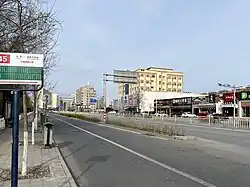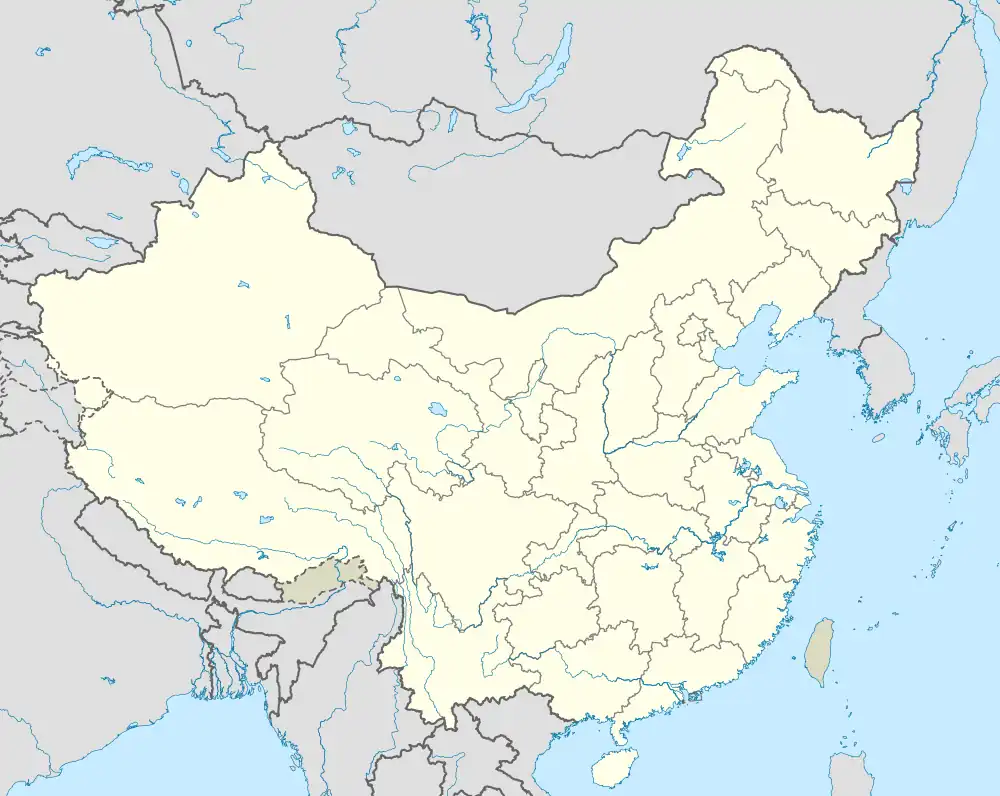Xiaotangshan Town
小汤山镇 | |
|---|---|
 Xiaotangshan as seen from Litang Road | |
.png.webp) Location inside of Changping District | |
 Xiaotangshan Town  Xiaotangshan Town | |
| Coordinates: 40°10′33″N 116°23′37″E / 40.17583°N 116.39361°E | |
| Country | China |
| Municipality | Beijing |
| District | Changping |
| Village-level Divisions | 6 community 24 villages |
| Area | |
| • Total | 69.95 km2 (27.01 sq mi) |
| Elevation | 37 m (121 ft) |
| Population (2020) | |
| • Total | 80,273 |
| • Density | 1,100/km2 (3,000/sq mi) |
| Time zone | UTC+8 (China Standard) |
| Postal code | 102211 |
| Area code | 010 |
Xiaotangshan Town (simplified Chinese: 小汤山镇; traditional Chinese: 小湯山鎮; pinyin: Xiǎotāngshān Zhèn) is a small town in the Changping District of Beijing, China.[1] It lies immediately outside Beijing's 6th Ring Road, to the north of the city. According to the 2020 census, Xiaotangshan was home to 80,273 inhabitants.[2]
With a total area of 70.1 square kilometers, Xiaotangshan has rich geothermal resources, so much so that the name Xiaotangshan (Chinese: 小汤山; lit. 'Small Hot Spring Mountain') originated from its abundance of geothermal springs.[3] Xiaotangshan Hospital appeared in the news in May 2003 when the government hastily built a 1000-bed field hospital there to deal with an outbreak of SARS.[4][5]
History
| Year | Status | Under |
|---|---|---|
| 1949–1956 | 4th District | Changping County |
| 1956–1958 | Sixiao District | |
| 1958–1982 | Xiaotangshan People's Commune (Beiqijiazhuang, Songlanbao and Shahe Working Stations separated away in 1959) | |
| 1982–1990 | Xiaotangshan Township | |
| 1990–1999 | Xiaotangshan Town (Integrated Dadongliu Township in 1997) | |
| 1999–present | Changping District |
Administrative divisions
By 2021, Xiaotangshan Town was divided into 30 subdivisions, more specifically 6 communities and 24 villages:[6]
| Administrative Division Code | Subdisvision Names | Name Transliteration | Type |
|---|---|---|---|
| 110114110001 | 市场街 | Shichangjie | Community |
| 110114110003 | 大东流 | Dadongliu | Community |
| 110114110004 | 太阳城 | Taiyangcheng | Community |
| 110114110005 | 汤南 | Tangnan | Community |
| 110114110006 | 龙脉 | Longmai | Community |
| 110114110007 | 金汤 | Jintang | Community |
| 110114110201 | 小汤山 | Xiaotangshan | Village |
| 110114110202 | 尚信 | Shangxin | Village |
| 110114110203 | 讲礼 | Jiangli | Village |
| 110114110204 | 马坊 | Mafang | Village |
| 110114110205 | 官牛坊 | Guanniufang | Village |
| 110114110206 | 阿苏卫 | Asuwei | Village |
| 110114110207 | 葫芦河 | Huluhe | Village |
| 110114110208 | 大柳树 | Daliushu | Village |
| 110114110209 | 大汤山 | Datangshan | Village |
| 110114110210 | 后牛坊 | Houniufang | Village |
| 110114110211 | 大东流 | Da Dongliu | Village |
| 110114110212 | 土沟 | Tugou | Village |
| 110114110213 | 酸枣岭 | Suanzaoling | Village |
| 110114110214 | 前蔺沟 | Qian Lingou | Village |
| 110114110215 | 后蔺沟 | Hou Lingou | Village |
| 110114110216 | 小东流 | Xiao Dongliu | Village |
| 110114110217 | 常兴庄 | Changxingzhuang | Village |
| 110114110218 | 大赴任庄 | Da Furenzhuang | Village |
| 110114110219 | 小赴任庄 | Xiao Durenzhuang | Village |
| 110114110220 | 赴任辛庄 | Furenxinzhuang | Village |
| 110114110221 | 南官庄 | Nanguanzhuang | Village |
| 110114110222 | 赖马庄 | Laimazhuang | Village |
| 110114110223 | 西官庄 | Xi Guanzhuang | Village |
| 110114110224 | 东官庄 | Dong Guanzhuang | Village |
Hot springs
Xiaotangshan has a long history of geothermal hot spring. The use of hot spring water can be traced back to the Southern and Northern Dynasties period of China, dating back over 1,500 years ago. The Xiaotangshan hot springs has records of early emperors using the springs for medical baths. The Qianlong Emperor of the Qing dynasty built the Xiaotangshan imperial palace and inscribed "九华兮秀". The hot spring water contains minerals and trace elements such as strontium, lithium, selenium, and other silicic acid mineral elements.
Xiaotangshan has rich geothermal resources. In Xiaotangshan center, resources are within 30 kilometers of ground water. Deep geothermal water depth in regions ranging from about 150–1400 meters to Xiaotangshan for the most shallow, less than one hundred meters. Due to the different regions and the depth of water, the water temperature is different, mostly in the 40-50 °C, the highest in the central area of Xiaotangshan 55-64 °C.
Economy
In 1994, Xiaotangshan town was named the pilot town for the construction of small towns in Beijing. In 1995, it was identified as the national pioneer town of comprehensive reform. In 2002, it was named by the United Nations Development as the small pilot town for sustainable development in China. In 2003 it was named "National Environmentally Beautiful Town" by the National Environmental Protection Administration. In 2004, it was identified as the first batch of national development and Reform pilot town and the Ministry of Construction and other six ministries identified it as one of the 1887 focus town. In 2005, the China Mining Association named Xiaotangshan as "Chinese hot springs town", and the National Steering Committee awarded it as "spiritual civilization advanced the town".
Features
- Xiaotangshan Palace, The Hot Springs and The Xiaotangshan Dragon Venture Hot Springs Plaza.
- Xiaotangshan Hospital, a hospital near Xiaotangshan hot spring, which became famous during the 2003 SARS epidemic. This saw a sudden increase in patients with the same condition and similar needs, and so an additional 'Rehabilitation Hospital' was built adjacent to the hospital site in little more than a week.[5] The temporary structure, built of prefabricated units and with a service life of 3 years, was operational for 51 days in 2003, from April 30 to June 20.[7] Subsequently, it was 'quietly abandoned'[8] and in 2010 was to be demolished.[7] It was rebuilt due to the COVID-19 pandemic.[9]
- Xiaotangshan Modern Agricultural Science Demonstration Park, the largest modern agricultural park in China.[10]
Transport
See also
References
- ↑ Modern Agricultural Science Demonstration Park at Xiaotangshan Chineseoo.com Archived September 27, 2007, at the Wayback Machine accessed 2020-02-06.
- ↑ "北京市昌平区第七次全国人口普查公报". bj.bjd.com.cn (in Chinese (China)). Retrieved 2022-10-18.
- ↑ Zhong hua ren min gong he guo zheng qu da dian. Bei jing shi juan. Li li guo, Li wan jun, Wu shi min, 李立国., 李万钧., 吴世民. Bei jing: Zhong guo she hui chu ban she. 2013. ISBN 978-7-5087-4058-4. OCLC 910451741.
{{cite book}}: CS1 maint: others (link) - ↑ China Times
- 1 2 China rushes to build new hospital for virus care: The facility in the central city of Wuhan is expected to be in use by February 3 (2020) 2 February 2020, www.asiatimes.com, accessed 2020-02-06.
- ↑ "2021年统计用区划代码和城乡划分代码". www.stats.gov.cn. Retrieved 2022-10-20.
- 1 2 Expert Interpretation: Why Xiaotangshan was demolished after seven years 2010-04-10 www.cyol.net Archived August 15, 2019, at the Wayback Machine accessed 2020-02-06.
- ↑ Williams, Sophie (2020-01-31). "How can China build a hospital so quickly?". BBC News. Retrieved 2020-02-07.
- ↑ 张洁. "Beijing to rebuild Xiaotangshan Hospital to fight virus - Chinadaily.com.cn". www.chinadaily.com.cn. Retrieved 2020-02-07.
- ↑ Investment Changping/ Xiaotangshan modern agricultural technology demonstration park Archived September 28, 2007, at the Wayback Machine, accessed 2020-02-06.
External links
- (in Chinese) Xiaotangshan website
- Changping District website